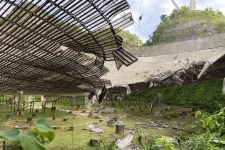A broken cable at Puerto Rico's Arecibo Observatory has torn a gaping 100-foot hole in the dish of one of the largest radio telescopes in the world, taking the instrument offline until repairs can be made.
Arecibo's massive reflector dish, which is built inside a sinkhole in northern Puerto Rico, was damaged when a 3-inch diameter support cable unexpectedly snapped before dawn on Monday, according to the University of Central Florida, which manages the observatory.
In a photo of the damage, twisted panels that make up the 1,000-foot dish can be seen hanging from the structure or lying on the ground beneath it.
When the cable fell, it also damaged several panels on the Gregorian Dome that is suspended above the dish and houses sensitive receivers to collect signals from space.
"We have a team of experts assessing the situation," Francisco Cordova, director of the observatory, said in a statement emailed to NPR. "Our focus is assuring the safety of our staff, protecting the facilities and equipment, and restoring the facility to full operations as soon as possible, so it can continue to assist scientists around the world."
The statement said it is not yet clear what caused the cable to break and it did not give a timetable for repairs.
In an email to NPR, Ramon Lugo III, director of the University of Central Florida's Florida Space Institute, said that "the removal of the damaged cable and the procurement of a cable to replace the damaged cable" were under assessment.
"We are also working on a determination of the cause of this failure, including non-destructive testing of the remaining cables," he said, adding that after a full assessment, "we will develop a recovery plan, schedule and budget."
Since its completion in 1963, Arecibo has played a key role in discoveries ranging from new insights into pulsars to detecting planets outside our solar system. It has figured prominently in the Search for Extraterrestrial Intelligence, or SETI. The observatory was also featured in the film Contact and the James Bond movie GoldenEye.
The observatory held the record for the world's largest radio telescope until 2016 when an even larger instrument of similar design, known as the Five-hundred-meter Aperture Spherical Radio Telescope, was completed in southern China. After testing, FAST officially went online last year.
In 2017, one of Arecibo's much smaller dishes and a few panels on the main dish were damaged when Category 4 Hurricane Maria raked the island.

Arecibo's massive reflector dish, which is built inside a sinkhole in northern Puerto Rico, was damaged when a 3-inch diameter support cable unexpectedly snapped before dawn on Monday, according to the University of Central Florida, which manages the observatory.
In a photo of the damage, twisted panels that make up the 1,000-foot dish can be seen hanging from the structure or lying on the ground beneath it.
When the cable fell, it also damaged several panels on the Gregorian Dome that is suspended above the dish and houses sensitive receivers to collect signals from space.
"We have a team of experts assessing the situation," Francisco Cordova, director of the observatory, said in a statement emailed to NPR. "Our focus is assuring the safety of our staff, protecting the facilities and equipment, and restoring the facility to full operations as soon as possible, so it can continue to assist scientists around the world."
The statement said it is not yet clear what caused the cable to break and it did not give a timetable for repairs.
In an email to NPR, Ramon Lugo III, director of the University of Central Florida's Florida Space Institute, said that "the removal of the damaged cable and the procurement of a cable to replace the damaged cable" were under assessment.
"We are also working on a determination of the cause of this failure, including non-destructive testing of the remaining cables," he said, adding that after a full assessment, "we will develop a recovery plan, schedule and budget."
Since its completion in 1963, Arecibo has played a key role in discoveries ranging from new insights into pulsars to detecting planets outside our solar system. It has figured prominently in the Search for Extraterrestrial Intelligence, or SETI. The observatory was also featured in the film Contact and the James Bond movie GoldenEye.
The observatory held the record for the world's largest radio telescope until 2016 when an even larger instrument of similar design, known as the Five-hundred-meter Aperture Spherical Radio Telescope, was completed in southern China. After testing, FAST officially went online last year.
In 2017, one of Arecibo's much smaller dishes and a few panels on the main dish were damaged when Category 4 Hurricane Maria raked the island.

